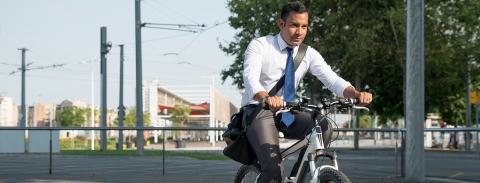6 Tips for Biking to Work Safely
6 Tips for Biking to Work Safely

According to the United States Census Bureau, the number of people who commute to work by bike nationally has increased roughly 60 percent during 2008 to 2012. Studies suggest that trend has continued in the last seven years, with cities scrambling to build infrastructure for bike commuters to support growing demand.
Aside from being a growing trend, riding a bicycle can also present health benefits like controlling your weight, improving sleep quality, reducing your risk of cardiovascular disease and chronic illnesses, reducing feelings of anxiety and depression, and more.
Currently only about 23% of American adults meet the exercise guidelines outlined by the Centers for Disease Control and Prevention: 150 minutes of moderate-intensity aerobic exercise a week. Commuting to work just 30 minutes round trip a day, five days per week would help meet these guidelines.
Thinking about bicycling to work or have already become a bike commuter? While biking to work is safer than it’s ever been before and presents numerous health benefits, there are still many precautions you need to take to ensure that you’re safe.
Always Wear A Helmet (No Exceptions)
Never ride a bicycle without a helmet. While it may be tempting to leave it off when you’re just biking down the street, a potentially devastating accident can happen at any time. A properly fitted helmet is effective for preventing traumatic brain injuries, the leading cause of death and disabling injuries for cyclists.
Ensure Your Bike is Road-Ready
Check all parts of the bicycle to make sure they are in proper working order. Obviously, this is key to riding your bike safely.
Ride a Bike Suited to You
Make sure your bicycle fits your body size. Some signs of an ill fitting bike include numbness or pain in the pelvis, neck, lower back, or extremities. Burning or tingling in your feet can also indicate ill-fitting shoes for cycling. Riding an ill-fitted bike isn’t just uncomfortable, but can also affect how your bike handles. If you’re going to be riding on the road or commuting to work on your bicycle, you want complete control over at all times.
Make Yourself Visible
Help other people on the road see you. Wear bright-colored clothes. Use reflectors on your bike to increase visibility for motorists, pedestrians and other cyclists. If you’re headed to work and don’t want to wear anything too flashy, wear a reflecting vest or similar while riding your bicycle and simply pack it away when you get to work.
Keep Your Eyes (and Mind) on the Road
Stay focused and alert when riding. Paying attention to your surroundings will help keep you safe. Avoid wearing distracting headphones that can hinder your ability to hear the traffic around you. No matter where you ride, you need to keep an eye out for cars and trucks.
Follow the Law
Legally, bicycles are categorized as vehicles just like cars or trucks. This means that you must follow all traffic laws that apply to motor vehicles, including obeying all traffic signs, signals and lane markings. When riding on the street, be sure to:
-
Go with the flow. Ride on the right in the same direction as traffic.
-
Yield to traffic. Most of the time, drivers on a smaller road must yield to traffic on bigger roads. If there is no stop sign or traffic signal and you are coming from a smaller roadway, slow down and see if the coast is clear before proceeding. Like any other vehicle, always yield to pedestrians at a crosswalk.
-
Be predictable. Ride in a straight line. Avoid weaving in and out of cars. Always signal your moves to others so they know where you are headed.
-
Stay alert. Avoid hitting potholes, cracks, wet leaves, storm grates, railroad tracks or anything that could make you lose control of your bike.
-
Turn carefully. Always look behind you for a break in traffic and signal before making any turn.
Be aware of parked cars. Ride far enough away from the curb to avoid potential collisions with parked cars from doors opening, cars pulling out or similar.

August is National Make-a-Will Month: How you can make a difference at UMD

2023 Alumni Survey Results

There's a Terp for That - How Alumni Experts are Uplifting Their Alma Mater

